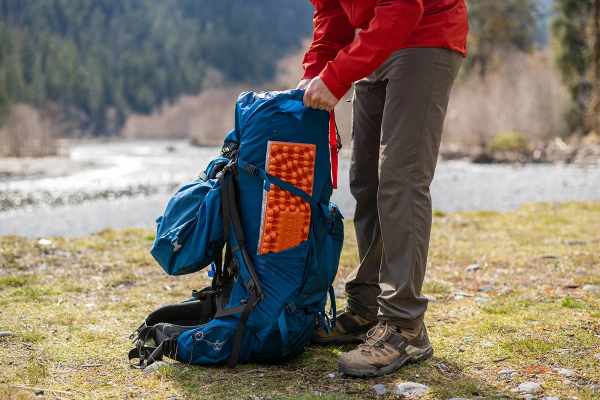Backpacking is a unique and immersive form of camping that combines the adventure of hiking with the essentials of wilderness survival. Unlike car camping or glamping, where comfort and convenience are often prioritized, backpacking requires careful consideration of every item brought along due to the need to carry all gear on one’s back. The key to a successful backpacking trip lies in efficient packing and prioritizing lightweight, durable gear. Factors such as the length of the trip, the destination, and weather conditions play a crucial role in determining what to pack.
The Big Three (Essential Gear)
SEE ALSO:What to Bring on a Week Long Camping Trip
When preparing for a backpacking trip, the “Big Three” refers to the most critical and often heaviest items: the backpack, tent, and sleeping system.
Backpack
Choosing the right backpack is fundamental for a comfortable and enjoyable backpacking experience. Backpacks come in various types, including frameless, internal frame, and external frame.
Frameless: Lightweight and simple, suitable for shorter trips with lighter loads.
Internal Frame: Offers better support and stability, ideal for longer trips and heavier loads.
External Frame: Provides excellent ventilation and load distribution but is bulkier and less popular than internal frame designs.
When selecting a backpack, ensure it fits your torso length and has an adjustable hip belt. A properly fitted backpack will distribute weight evenly, reducing strain on your shoulders and back. Packing strategies are also vital; place heavier items close to your back and center for optimal balance and stability.
Tent
A good backpacking tent should be lightweight, compact, durable, and weather-resistant. Options range from single-person tents to larger double or even triple-person tents, with each type catering to different needs and preferences.
Single-Person Tents: Lightweight and easy to carry, perfect for solo adventurers.
Double-Person Tents: Offer more space and comfort, ideal for couples or friends.
Three-Person Tents: Provide ample space for gear and occupants but are heavier and bulkier.
Setup considerations include ease of assembly, ventilation, and stability in various weather conditions. Look for tents with a good balance of weight and durability, ensuring they can withstand wind, rain, and other environmental factors.
Sleeping System
A comfortable and warm sleeping system is essential for a good night’s rest. This system typically includes a sleeping bag and a sleeping pad.
Sleeping Bag: Choose based on temperature rating, weight, and packability. Synthetic and down insulation options are available, with down being lighter and more compressible but less effective when wet.
Sleeping Pad: Provides insulation and comfort, preventing heat loss to the ground. Options include foam pads, self-
inflating pads, and inflatable air pads.Consider the expected weather conditions and your personal comfort preferences when selecting your sleeping gear. A well-chosen sleeping system will enhance your overall backpacking experience.
Clothing and Personal Items
Clothing
Layering is the key to dressing for various weather conditions on a backpacking trip. Prioritize lightweight, quick-drying fabrics that provide flexibility and comfort.
Base Layers: Moisture-wicking materials to keep you dry.
Insulating Layers: Fleece or down jackets for warmth.
Waterproof Outer Layer: A good-quality rain jacket and pants.
Hiking Socks: Comfortable, moisture-wicking, and durable.
Other essential clothing items include a hat, gloves, and appropriate underwear. Always pack extra socks and a spare set of clothes in case of unexpected weather changes.
Footwear
Proper footwear is crucial for a comfortable and injury-free backpacking trip. Choose hiking boots that provide support, durability, and comfort.
Hiking Boots: Ensure a good fit with adequate support and protection.
Break them in before your trip to prevent blisters and discomfort.
Trail Runners: Lighter and more flexible, suitable for well-maintained trails.
Pair your footwear with moisture-wicking, cushioned hiking socks to prevent blisters and keep your feet dry.
Personal Items
Essential personal items include hygiene products, first aid supplies, sun protection, and navigation tools.
Hygiene: Biodegradable soap, a toothbrush, toothpaste, and a small towel.
First Aid Kit: Include bandages, antiseptic wipes, pain relievers, and any personal medications.
Sun Protection: Sunscreen, lip balm with SPF, and a wide-brimmed hat.
Navigation: Map, compass, GPS device, and a reliable watch.
Opt for compact and lightweight versions of these items to minimize pack weight.
Cooking and Eating
Camp Stove
A reliable camp stove is essential for preparing meals on the trail. Lightweight and efficient stoves are ideal for backpacking.
Fuel Options: Gas canisters, liquid fuel, or wood-burning stoves. Gas canisters are the most convenient and widely used.
Safety Considerations: Always fol


